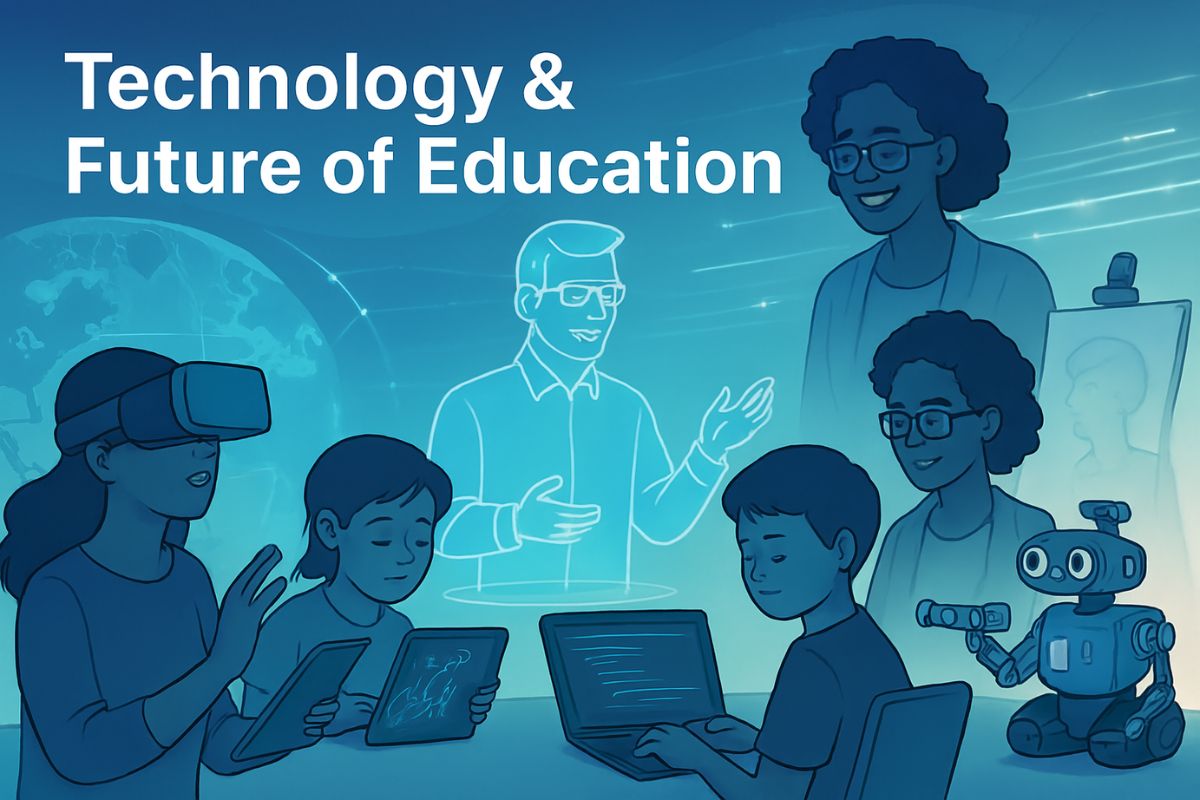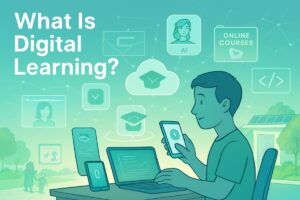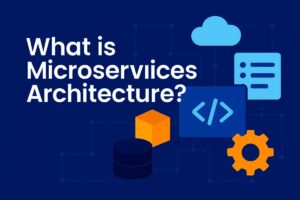- Technology is dramatically shaping the future of education, making learning more accessible, personalized, and engaging.
- Innovations like AI, VR, online platforms, and adaptive learning systems are redefining traditional classrooms.
- Teachers and students must adapt to emerging technologies to stay relevant.
- The global education landscape is becoming more inclusive and skill-focused.
- This blog explores trends, challenges, and actionable insights into the evolving educational paradigm.
We stand at the crossroads of a remarkable transformation. The integration of technology and the future of education is not just a trend—it’s a revolution. From the chalkboard to the smartboard, from rote memorization to personalized learning paths, technology is fundamentally reshaping how knowledge is delivered, consumed, and applied. This evolution isn’t confined to one country or demographic; it’s a global shift that promises to redefine education for generations to come. In this comprehensive guide, we dive deep into how technology and the future of education are intertwined, what it means for curious learners like you, and how you can prepare for this exciting journey ahead.
The Evolution: How Technology is Reshaping Education
From Traditional to Technological Classrooms
For decades, classrooms have operated under a one-size-fits-all model. But with technology’s advent:
- Personalized Learning: AI-powered platforms adjust lessons based on a student’s pace and understanding.
- Blended Learning Models: Combining online and offline methods fosters flexibility.
- Global Access: Students in remote areas now access world-class courses.
| Traditional Model | Technological Model |
|---|---|
| Fixed curriculum | Adaptive learning paths |
| Limited resources | Infinite digital resources |
| Teacher-centered | Student-centered |
| Physical boundaries | Global classrooms |
Major Technologies Driving the Future of Education Technology
1. Artificial Intelligence (AI)
- Personalized tutoring
- Automated grading
- Predictive analytics for student performance
2. Virtual Reality (VR) & Augmented Reality (AR)
- Immersive historical tours
- Interactive science labs
- Real-world simulation training
3. Learning Management Systems (LMS)
- Centralized content delivery
- Performance tracking
- Communication platforms
4. Blockchain in Education
- Secure credential verification
- Transparent academic records
- Decentralized learning repositories
5. Internet of Things (IoT)
- Smart classrooms
- Connected devices for real-time feedback
- Data-driven insights for educators
The Benefits: Why Technology and the Future of Education Are a Perfect Match
- Accessibility: Students from rural or underserved communities can access quality education.
- Affordability: Reduced costs through online courses and digital textbooks.
- Customization: Adaptive learning meets individual student needs.
- Engagement: Gamification and interactive content make learning fun.
- Lifelong Learning: Continuous upskilling opportunities for professionals.
Challenges in Adopting Education Technology
While the future of education technology is bright, several hurdles remain:
- Digital Divide: Not all students have equal access to devices or stable internet.
- Teacher Training: Educators need consistent training to effectively use new tools.
- Privacy Concerns: Data security and student privacy must be safeguarded.
- Over-reliance on Technology: Critical thinking and interpersonal skills risk being overshadowed.
Key Trends Shaping the Future of Education Technology
1. Microlearning
- Short, focused content modules
- Ideal for busy professionals and younger audiences
2. Gamification
- Points, badges, leaderboards
- Enhances motivation and retention
3. AI Tutors and Chatbots
- Instant feedback
- Personalized guidance
4. Skill-Based Learning
- Focus on soft skills, critical thinking, and creativity
- Industry-aligned certifications
5. Global Collaboration Platforms
- Real-time projects with peers worldwide
- Exposure to diverse perspectives
The Role of Teachers in the Future of Education Technology
Even as technology advances, educators remain irreplaceable. Their roles are evolving:
- Facilitators of Critical Thinking
- Mentors for Emotional Intelligence
- Curators of Authentic Learning Experiences
- Adaptors of Emerging Tools
Teachers must continually upskill to integrate technology effectively while preserving the human touch essential for holistic education.
Preparing Students for a Tech-Driven Future
Essential Skills for Future Learners
- Digital literacy
- Problem-solving
- Collaboration across cultures
- Adaptability
- Continuous learning mindset
How Parents Can Support
- Encourage exploration of technology
- Set healthy screen time boundaries
- Foster critical thinking and creativity
Role of Governments and Policymakers
- Invest in digital infrastructure
- Offer subsidized devices
- Mandate teacher training programs
- Protect data privacy
FAQs: Technology and the Future of Education
1. How is technology changing the future of education?
Technology enables personalized, accessible, and engaging learning experiences through AI, VR, and global online platforms.
2. What are the challenges in adopting technology in education?
Challenges include digital inequality, inadequate teacher training, privacy concerns, and potential over-dependence on technology.
3. Will technology replace teachers in the future?
No. While technology enhances learning, teachers remain vital for mentoring, critical thinking development, and emotional support.
4. What is the role of AI in the future of education technology?
AI offers adaptive learning paths, instant feedback, automated grading, and predictive analytics to improve educational outcomes.
5. How can VR and AR benefit education?
They provide immersive, experiential learning environments, making complex concepts easier to understand and retain.
6. What skills are essential for students in the future of education?
Key skills include digital literacy, problem-solving, adaptability, collaboration, and lifelong learning.
7. How can developing countries benefit from education technology?
Through affordable online platforms, digital libraries, and mobile learning apps, even remote areas gain access to quality education.
8. What is the future of higher education with technology?
Higher education will become more flexible, skill-based, and globally accessible with online degrees, micro-credentials, and hybrid models.
9. How can parents help children adapt to education technology?
By creating a balanced tech-friendly environment, monitoring content, and encouraging active rather than passive learning.
10. What are microlearning and its benefits?
Microlearning delivers short, focused lessons that enhance engagement, retention, and allow learners to study at their own pace.
Conclusion: Embrace the Change, Shape the Future
The integration of technology and the future of education presents a once-in-a-lifetime opportunity to redefine learning. As curious readers and lifelong learners, staying informed and adaptable is crucial. Whether you’re a student, parent, educator, or policymaker, your proactive engagement will shape this new educational era. Embrace these innovations, share your thoughts in the comments, and join the global conversation shaping the classrooms of tomorrow!



